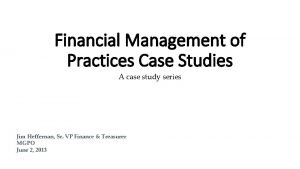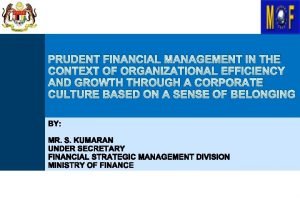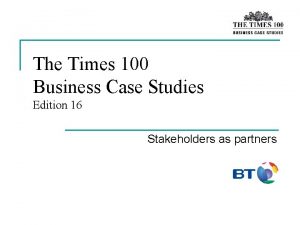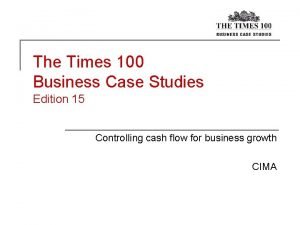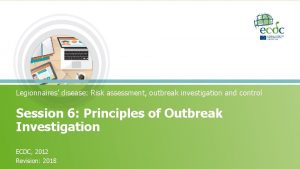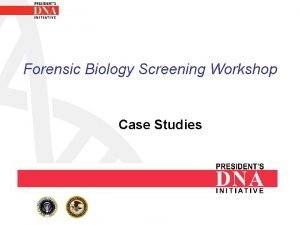Financial Management of Practices Case Studies A case












- Slides: 12

Financial Management of Practices Case Studies A case study series Jim Heffernan, Sr. VP Finance & Treasurer MGPO June 2, 2013

2

Case Review Module 2 - Finance and Budgeting Case Study 3

Budget and Financial Planning ? 4

What are the major items affecting a physician practice financial plan? ü ü ü 5 Patient Volumes Service Mix Reimbursement rates Physician comp plans Staffing levels Capital

What items should concern Mark? What would you want to know? ü Why is there a negative operating margin? ü Are there barriers to generating a positive margin? ü What is driving the drop in patient cash? ü Why is Operational Support decreasing? ü Are there other opportunities in Other Revenue? ü Is my staffing ratio adequate? ü Why are MD Salaries and additional comp increasing so rapidly ü Is there benchmark data we can review and compare against? 6

How might you explain the change in Patient Cash? How much is volume affecting this? Decrease in patient cash is caused by a combination of a lower payment per unit and lower volume. Of the ($1. 3 M) total decrease, ($. 3 M) is related to rate, and ($1. 0 M) is related to volume. FY 11 Actual Revenue (000’s) Volume Price per Unit FY 12 Budget $13, 096, 355 $11, 729, 517 ($1, 366, 838) 87, 000 80, 000 (7, 000) $150. 53 $146. 62 ($3. 91) Price Variance: (Actual P – Budget P ) * Actual Q ($150. 53 - $146. 62) * 80, 000 = ($313, 108) Lower Price per Unit ($313, 108) Volume Variance: Lower Total Quantity ($1, 053, 730) (Actual Q – Budget Q ) * Budget P Total ($1, 366, 838) (87, 000 – 80, 000) * 150. 53 = ($1, 053, 730) Amounts are rounded 7 Variance

What might you do about the “promised” bonus? ü Determine if “promised” means “guaranteed” ü Options to tie it more closely to performance? ü Remove it from the budget ü Review parameters of comp plans ü Other ideas? 8

What opportunities do you see to improve the planned margin? ü ü ü Increase clinical hours Increase volumes via efficiency measures Options to generate non-patient revenue Change in service mix Revert to the 4% benchmark MD salary increases ü Remove “promised” bonus ü What else? 9

Can Mark and Andy get to a positive margin? ü Possibly. Definitive estimates of specific items were accounted for, but have not been vetted fully. Even with what is presented, there is still a small margin deficit. ü The idea is to put all the options on the table, measure them, and be deliberate in the approach towards implementation. ü If they are NOT on the table, then they most likely will never occur. ü The budget is a perfect place to outline the various scenarios. 10

Financial Performance Measures • Modified cash versus accrual • Cash margin • Percent of revenue by expense category • Percent net distributable income • • • Revenue per physician Staffing per physician Revenue per 1000 square feet Ancillary revenue percent of total revenue Relevant to health system operations and organizations issuing debt • Net operating income • Days cash on hand • Percent operating revenue by category • Net patient service revenue • Risk contract revenue

 Financial management case study
Financial management case study Prudent practices for organization growth and development
Prudent practices for organization growth and development Paradigm shift from women studies to gender studies
Paradigm shift from women studies to gender studies Illegal financial practices
Illegal financial practices Best worst and average case
Best worst and average case Nss business accounting and financial studies
Nss business accounting and financial studies Advantages of descriptive research
Advantages of descriptive research Times 100 business case studies
Times 100 business case studies Times 100 business case studies
Times 100 business case studies Holistic technology in human values
Holistic technology in human values Example of outbreak
Example of outbreak Case series
Case series Eu-gdpr-p
Eu-gdpr-p
